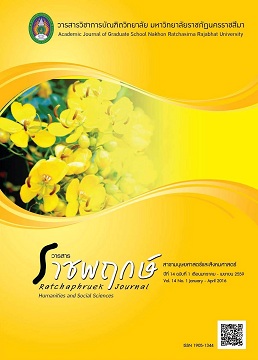การพัฒนาแบบทดสอบวินิจฉัยข้อบกพร่องทางการเรียนวิชาคณิตศาสตร์ เรื่องสมการและการแก้สมการ สำหรับนักเรียนชั้นประถมศึกษาปีที่ 6
Main Article Content
Abstract
การวิจัยครั้งนี้มีวัตถุประสงค์เพื่อพัฒนาและหาคุณภาพของแบบทดสอบวินิจฉัยข้อบกพร่องทางการเรียนวิชาคณิตศาสตร์ เรื่องสมการและการแก้สมการ สำหรับนักเรียนชั้นประถมศึกษาปีที่ 6 กลุ่มตัวอย่างที่ใช้ในการวิจัย เป็นนักเรียนระดับชั้นประถมศึกษาปีที่ 6 สังกัดสำนักงานเขตพื้นที่การศึกษาประถมศึกษานครราชสีมา เขต 1 ปีการศึกษา 2556 จำนวน 617 คน ได้มาโดยวิธีการสุ่มแบบหลายขั้นตอนการดำเนินการสร้างแบบทดสอบเริ่มจากสร้างแบบทดสอบสำรวจชนิดให้แสดงวิธีทำเติมคำตอบ พร้อมทั้งให้เหตุผล เพื่อค้นหาข้อบกพร่อง ในการตอบผิดของผู้เรียน หลังจากนั้นรวบรวมคำตอบผิดนำมาสร้างแบบทดสอบวินิจฉัย แบบเลือกตอบ 4 ตัวเลือก โดยนำคำตอบที่นักเรียนส่วนใหญ่ตอบผิดในแบบทดสอบสำรวจมาสร้างเป็นเป็นตัวลวง แล้วนำไปทดลองสอบ 3 ครั้ง ผลการวิจัยพบว่า แบบทดสอบวินิจฉัย ฉบับที่ 1 มีค่าอำนาจจำแนกตั้งแต่ 0.20–0.46 มีค่าความเชื่อมั่นเท่ากับ 0.78 และมีคะแนนจุดตัดเท่ากับ 10 คะแนน แบบทดสอบวินิจฉัยฉบับที่ 2 มีค่าอำนาจจำแนกตั้งแต่ 0.22–0.58 มีค่าความเชื่อมั่นเท่ากับ 0.87และมีคะแนนจุดตัด เท่ากับ 13 คะแนนแบบทดสอบวินิจฉัยฉบับที่ 3 มีค่าอำนาจจำแนกตั้งแต่ 0.29–0.74 มีค่าความเชื่อมั่นเท่ากับ 0.94 และมีคะแนนจุดตัดเท่ากับ 14 คะแนน และค่าความเที่ยงตรงตามเนื้อหาของแบบทดสอบวินิจฉัยทั้ง 3 ฉบับ ที่พิจารณา โดยผู้เชี่ยวชาญทางด้านเนื้อหาและด้านวัดผลพบว่า มีค่าเท่ากับ 1.00 ทุกข้อ
The Development of Mathematics Learning DiagnosticI Test on Equations and Solving Equations for Prathomsuksa 6 Students
The purpose of this research was to develop a mathematics learning diagnostic test on equations and solving equations for prathomsuksa 6 students. The samples of 617 students were selected by multi stage random sampling technique from prathomsuksa 6 of the department of academic year 2013. The test construction included the survey test in the form of completing item for identify the errors from the response of students and the test for diagnostic in the form of four multiple choices test alternatively which obtained from the survey test. The diagnostic test was 3 times of pilot study. The result of the study revealed that the first subtest had the discrimination index ranged from 0.20-0.46, the reliabilities were 0.78 and the cutting score were 10. The second subtest had the discrimination index ranged from 0.22-0.58, the reliabilities were 0.87 and the cutting score were 13. The third subtest had the discrimination index ranged from 0.29-0.74, the reliabilities were 0.94 and the cutting score were 14. The validity of 3 subtests were 1.00


